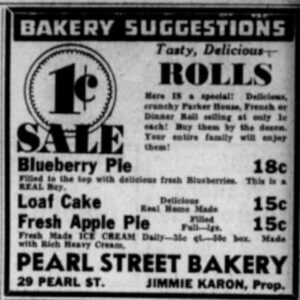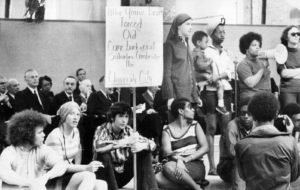
In Marcine Karon’s lifetime, there was little need to leave Central, and Harvard was another world
Above image: Marcine Karon at Christmas in 2018. (Photo: Karon family)
By Gretchen G. Adams
An article in an occasional series about Cambridgeport residents, sponsored by History Cambridge.
Ever wonder what stood on the site now occupied by the brutalist hulk of the Central Square library branch and parking garage? Marcine Karon can tell you! Now 96 years old, Marcine has lived her entire life within blocks of that location. Her father James, a Greek immigrant from Asia Minor, operated the Pearl Street Bakery, Magnet luncheonette and a wholesale baked goods operation at that location. Marcine attributes her father’s runaway success to his skill whipping up delicious eclairs, morning buns, coffee rings, blueberry muffins and Boston cream pies (no Greek items – he didn’t think they would be popular). And to a second factor: The enterprise was next to a bus stop for a popular route. Waiting passengers couldn’t resist the lovely aromas wafting out of the shop, and ducked in to buy a treat or to sit down at the luncheonette for a soda from the fountain. Business was particularly good on rainy days.
Marcine was well acquainted with her father’s work. While paid employees sometimes helped themselves to cash from the till, James knew he could trust his children. Like her four siblings, Marcine started working at an early age. She arrived at the shop each weekday at 7 a.m. Bad were the days when she had to go in even earlier! If the phone rang at 5:30 a.m., she knew her father was calling to say that the assistant baker had not shown up and one of the kids would have to fill in. Arguments naturally ensued among the children about whose turn it was to rush over.
After school, Marcine had to scurry right back to the bakery, where she was on duty from 3 to 7 p.m. Her first job in the afternoons was to restock the mouthwatering display trays arrayed behind the big plate glass windows. A whiz at math, she often ran the cash register while her brothers worked at the soda fountain, mixing sugary carbonated drinks for customers seated at the 20 stools along the counter.
Marcine’s dad worked seven days a week, sometimes not even coming home to sleep during the holiday season. Despite his grueling schedule, he was kind, always smiling. Although he didn’t pay his children salaries, he was generous with cash, usually forking over a bit of dough when asked.
Marcine’s mother Cleopatra (née Babalas) Karon worked every bit as hard as her husband. She gave birth to five children in eight years. Nursing one child while pregnant with the next, corralling toddlers, washing cloth diapers and linens, cooking three meals a day (even when they were in school and the children came home for lunch), and keeping her house immaculate (she had high standards for cleanliness) took every bit of her energy, leaving her bone tired. Marcine remembers her mother finding solace in her garden. Cleopatra had planted five grape vines that she tended lovingly, harvesting grape leaves for stuffing and boiling down the fruit into juice and jellies.
Marcine attended the nearby Webster School on Upton Street (now the Amigos School). Because Marcine was a studious child who excelled in all subjects, teachers decided to double skip her, promoting her to the fifth grade from the third. When she was in the fifth grade, Marcine had a set-to with her teacher, Miss Grant: For having spoken out of turn, little Marcine – by far the youngest in the class – was in big trouble. Miss Grant told Marcine to go home immediately and return with one of her parents so Miss Grant could tell them what a bad child they had raised. Marcine was livid. She couldn’t ask her father to come; he was busy at work. Her mother didn’t speak English. What to do? Marcine settled on expressing her frustration by kicking Miss Grant in the shins and dashing out the door. Marcine didn’t return to school for an entire week. Many years later, when Marcine’s children attended the Webster School, two of the three were assigned to Miss Grant, who was still teaching.

When she started high school at Cambridge Latin, Marcine met children from other parts of Cambridge for the first time. As a little girl, Marcine had rarely ventured out of Cambridgeport. Why would she? Everything she needed or wanted, including 20 first cousins, was close at hand. Marcine remembers the girls from Harvard Square being snooty, rarely deigning to speak with girls from Central Square, many of whom spoke accented English.
In high school, Marcine continued to shine academically. She yearned to go to college and train to become a teacher. Although Marcine had the grades to be accepted to a competitive university, her mother refused to give permission for her to apply. According to her, the only thing girls learned in college was how to drink alcohol. Attending a music school was, however, acceptable to Cleopatra. So Marcine, who had studied piano since she was small, enrolled at the New England Conservatory. Having grown up listening mostly to Greek music at home, Marcine was transported as she learned compositions by classical composers such as Beethoven and Chopin, who quickly became her favorites. At the conservatory, Marcine became such an accomplished musician that the Boston Symphony Orchestra invited her to audition – but on the double harp, not the piano.
Although she didn’t get to teach in a public school, Marcine pursued her ambition to teach at the nearby Greek Orthodox church, where for decades she led religious education classes for children. Among her other innovations was describing the lives of the saints by illustrating the stories with images she had cut from felt that she stuck onto a felt background.
Although her parents allowed only Greek music to be played aloud in the house, Marcine had a tiny transistor radio. Keeping it tucked under her pillow, she tuned in to big band jazz shows in bed at night. From friends, she learned the steps to popular dances, and was able to jitterbug with the best of them. She practiced athletic dance moves with a brother, allowing herself to be swooped low onto the floor on either side of and between his legs, flipped and spun at high speed. She won multiple dancing contests. Her high school classmates were so impressed with her dance skills that the editors of the high school year predicted she would be the proprietor of a successful dance studio as an adult.
A love of dancing and big band music drew her to the man she eventually married in July 18, 1948, Peter G. Nearhos. He played the trumpet in local big bands and was a fine dancer. They worked for Moller’s Furniture store in Central Square – she as an accountant, he as a furniture finisher. They were married for 22 years and had three children, Karen Nearhos Kosko, Jamie Nearhos (now deceased) and Jody Nearhos. Marcine now looks back contentedly on her life in Cambridgeport. She wouldn’t have wanted to spend her life anywhere else.
Gretchen G. Adams is a volunteer for History Cambridge.
This article was originally published in our “Did You Know?” column in Cambridge Day.









